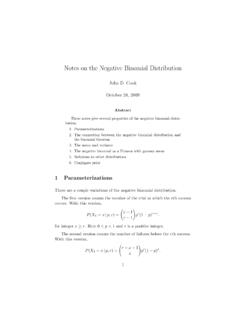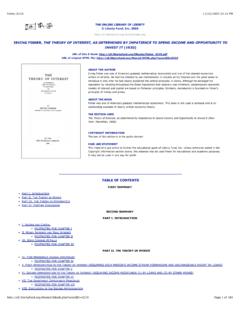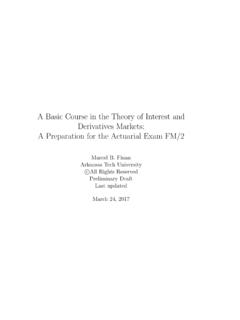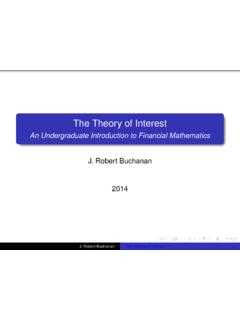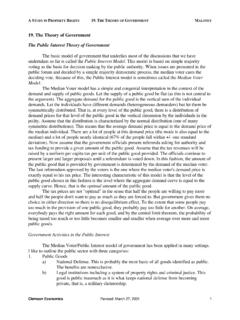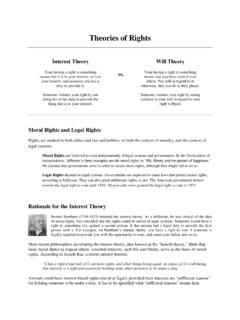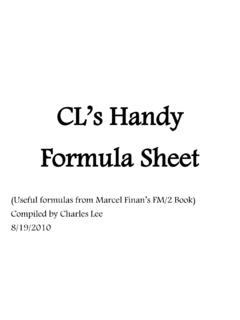Transcription of Theory of Interest - johndcook.com
1 Theory of InterestJohn CookJuly 7, 1992 VocabularyInterest periodsorconversion periodsare times when Interest is applied, such as monthly, quarterly, rateis the annual rate divided by the number of Interest periods per rateorannual percentage rateis the annual percentage of Interest not taking com-pounding into rateis the rate of Interest paid in one year, which takes compounding into example, a nominal Interest rate of 12%, compounded monthly has 12 Interest periods, a periodicrate of 1%, and an effective rate of valueof an amount is what that amount will be worth at a given point in the future givena certain rate of valueof an amount is the quantity of money that would have to be invested at a prescribedinterest rate to be worth that amount in the example, with the conditions of the previous example, the future value of $100 a year later is $ the present value of a $ payment one year in the future is $ a regular sequence of payments made at the end of a period.
2 Anannuity dueis thesame, except payments are made at the beginning of the present valueorNPVof an investment is the sum of the future values of all payments minusthe initial effective rate of a nominal Interest rateicompoundedmtimes in a year is(1 +i/m)m the periodic rate andnbe the number of periods. The present value of an amountPisP=F(1 +r) future value of an amountPisF=P(1 +r) Rule of 72 says that an amount invested at an annual rate ofi% will double in approximately 72 present value of an annuity ofnpayments of sizeRisP V A=R1 (1 +r) nrand the future value isF V A=R(1 +r)n present value of an annuity due ofnpayments of sizeRisR(1 +1 (1 +r) (n 1)r),an annuity ofn 1 payments plus the first payment. The future value isR((1 +r)n 1r 1),an annuity ofn+ 1 payments minus the last effective rate of an nominal ratercompounded continuously iser present value of an amountPcompounded continuously at a nominal raterisP ertat timet. The future value of an amountPsimilarly compouned isP e money is being continuously added to an annuity at an instantaneous ratef(t) over a timeinterval [0, T].
3 The present value of this annuity is T0f(t)e future value is T0f(t)er(T t) books use the notaionan|r 1 (1 +r) nr,the present value of an annuitynpayments of size 1 at a periodic same books usesn|r (1 +r)n 1r,the future value of an annuitynpayments of size 1 at a periodic rate: If a nominal Interest rateiis compoundedmtimes in a year, a period rate ofi/musappliedmtimes. Hence an amountPgrows toP(1 +i/m)m, an increase of ((1 +i/m)m 1) value: IncreasePby a raterovernperiods and you haveP(1+r)nat the end. Solve (1+r)nP=FforPto get present present value of an annuity is the sum of the present value of its payments, which is a geometricseries:n j=1R(1 +r) j=R1 (1 +r) values and annuities due are handled compounding: By taking the limit as the numer of Interest periods becomes infinite, we havelimm P(1 +rm)mt=P find out how long it takes for an amountPto double when compounded continuously, we need tosolveP ert= 2 Pfort, and we gett= ln 2/r= Thus if we round to 72%, we get the Rule of 72.
4 The derivation shows the limitations of the rule. First, it only applies to continous compounding, but formoderate Interest rates, the effective rate for continuous compounding is not too different from, say, quarterlycompounding. Just for the fun of it, we note that from the Taylor series forerwe see that the differencebetween continuous and quarterly compounding iser (1 +r4)4=r28+O(r3).Thus even for Interest rates around 20%, the difference is in the neighborhood of half a , it should be the Rule of 100 ln 2, or Rule of if we re willing to truncate a 72 is a nice number to work with since it is divisible by a lot of integers. Substituting 72 for 100 ln 2makes our estimates about 4% too annuities: Note that the present value of a paymentf(t) isf(t)e rt; integration adds theseup. For future value, note that each paymentf(t) earns Interest forT tyears and so has a future valuef(t)er(T t). Note that T0f(t)er(T t)dt=erT T0f(t)e rt)dt,which says that we could find the future value of annuity by first finding its present value and then findingthe future value of a lump sum equal to that amount.
5 On a more esoteric note, we observe that asTbecomeslarge, the present value off(t) approaches the Laplace transform off(t).4

